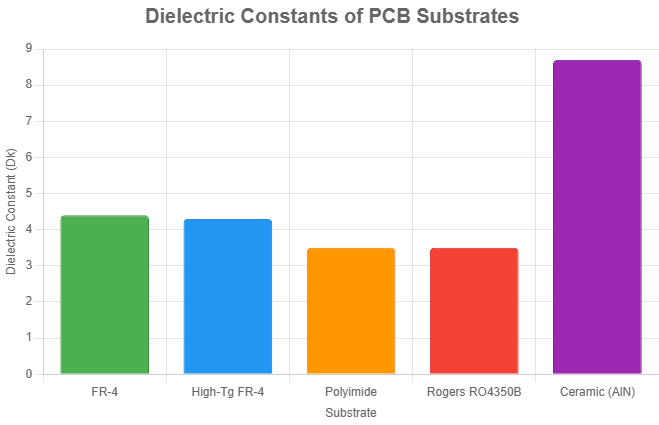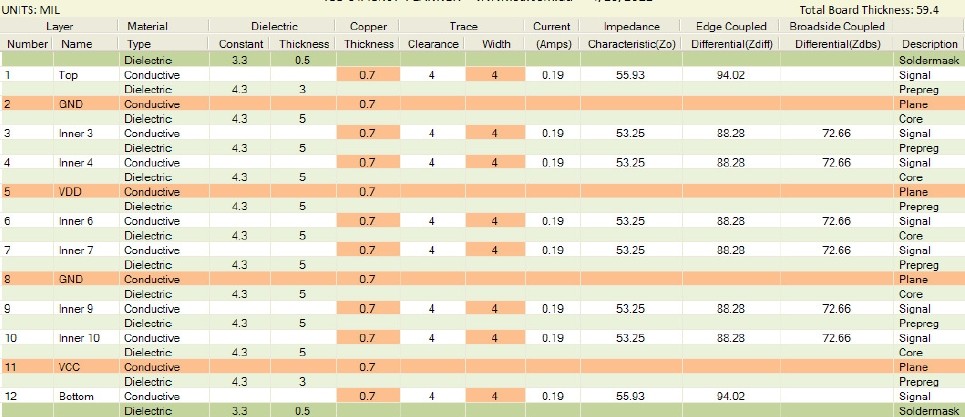When it comes to designing high-layer-count PCBs, selecting the right laminate material is critical for ensuring performance, reliability, and cost-effectiveness. High-layer-count PCBs, often used in advanced applications like telecommunications, aerospace, and medical devices, typically have 8 or more layers and demand materials that can handle complex signal integrity, thermal management, and mechanical stability. So, how do you choose the best laminate for these intricate boards? The answer lies in understanding high-layer-count PCB material properties, laminate selection criteria for PCBs, and the specific needs of high-frequency laminate for high-layer PCBs.
In this comprehensive guide, we'll dive deep into the factors that influence material selection for high-layer-count PCBs. From dielectric constants to thermal conductivity, we'll explore the properties that matter most and provide actionable insights to help engineers and designers make informed decisions for their projects.
Why Material Selection Matters for High-Layer-Count PCBs
High-layer-count PCBs are the backbone of modern electronics where space is limited, and performance is non-negotiable. These boards often integrate multiple functions into a single design, requiring precise signal transmission across numerous layers. The laminate material serves as the foundation of the PCB, providing electrical insulation, mechanical support, and thermal stability. A poor choice of laminate can lead to signal loss, overheating, or even board failure under stress.
Selecting the right material isn't just about meeting basic requirements; it's about optimizing for specific challenges like high-frequency signal integrity, impedance control, and long-term reliability. Let's break down the key considerations and criteria for choosing laminates tailored to high-layer-count designs.

Understanding High-Layer-Count PCB Material Properties
The performance of a high-layer-count PCB heavily depends on the material properties of the laminate. These properties dictate how well the board can handle electrical signals, heat dissipation, and physical stress. Below are the most critical material properties to consider:
1. Dielectric Constant (Dk)
The dielectric constant, often abbreviated as Dk, measures how much a material can store electrical energy. For high-layer-count PCBs, especially those operating at high frequencies, a low and stable Dk is essential to minimize signal delay and maintain impedance consistency across layers. Typical Dk values for standard laminates range from 3.5 to 4.5, while high-frequency laminates can go as low as 2.2 to 3.0 for better performance.
2. Dissipation Factor (Df)
The dissipation factor, or Df, indicates how much energy is lost as heat during signal transmission. A lower Df is crucial for high-frequency applications to reduce signal loss. For high-layer-count PCBs handling signals above 1 GHz, laminates with a Df of 0.002 or lower are often preferred.
3. Thermal Conductivity
With multiple layers packed into a compact space, heat dissipation becomes a significant concern. Materials with high thermal conductivity (measured in W/m·K) help transfer heat away from critical components. Standard laminates may have thermal conductivity around 0.3 W/m·K, while advanced materials can exceed 1.0 W/m·K for better heat management.
4. Coefficient of Thermal Expansion (CTE)
The CTE measures how much a material expands or contracts with temperature changes. Mismatched CTE between the laminate and copper layers can cause delamination or cracking in high-layer-count PCBs. Materials with a CTE close to copper (around 17 ppm/°C) are ideal to ensure reliability during thermal cycling.
5. Mechanical Strength
High-layer-count PCBs are often thicker and heavier, so the laminate must provide sufficient mechanical strength to prevent warping or bending during manufacturing and operation. Flexural strength and tensile strength are key metrics to evaluate when selecting a material for durability.
Picture Placement 2

Laminate Selection Criteria for PCBs
Choosing the right laminate for a high-layer-count PCB involves balancing performance requirements with cost and manufacturability. Here are the primary criteria to guide your decision:
1. Application-Specific Needs
The intended application of the PCB largely determines the laminate choice. For example, high-frequency applications like 5G telecommunications require laminates with low Dk and Df to maintain signal integrity at frequencies above 10 GHz. In contrast, industrial control systems might prioritize thermal stability and mechanical strength over high-frequency performance.
2. Layer Count and Stack-Up Complexity
As the number of layers increases, so does the complexity of the PCB stack-up. High-layer-count designs (12, 16, or even 24 layers) require laminates that maintain consistent electrical properties across all layers. Uniformity in thickness and dielectric properties helps avoid impedance mismatches and signal skew.
3. Signal Integrity and Impedance Control
In high-speed digital and RF circuits, maintaining controlled impedance is vital. Laminates must offer predictable and stable dielectric properties to ensure that traces on different layers have consistent impedance values, often within ±10% tolerance (e.g., 50 ohms for standard RF signals).
4. Cost Constraints
While advanced laminates offer superior performance, they often come at a higher cost. Standard FR-4 laminates are cost-effective for many applications but may not meet the needs of high-frequency or high-reliability designs. Balancing performance with budget is a key aspect of laminate selection.
5. Manufacturability
Not all laminates are easy to process, especially for high-layer-count boards. Some materials may require specialized drilling, lamination, or etching techniques, which can increase production time and cost. Ensure the chosen laminate is compatible with your manufacturing capabilities.

High-Frequency Laminate for High-Layer PCBs
High-frequency applications present unique challenges for high-layer-count PCBs. As signal frequencies increase, issues like signal loss, crosstalk, and electromagnetic interference (EMI) become more pronounced. Selecting a high-frequency laminate is crucial to address these challenges effectively.
Key Features of High-Frequency Laminates
High-frequency laminates are engineered to minimize signal loss and maintain integrity at frequencies ranging from 1 GHz to over 50 GHz. These materials typically feature:
- Low Dielectric Constant: Dk values as low as 2.2 to reduce signal propagation delay.
- Low Dissipation Factor: Df values below 0.002 to minimize energy loss.
- Smooth Surface Finish: Reduces skin effect losses at high frequencies by minimizing surface roughness on copper traces.
- Stable Performance: Consistent electrical properties over a wide range of frequencies and temperatures.
Common High-Frequency Laminate Types
Several types of laminates are designed specifically for high-frequency applications in high-layer-count PCBs:
- PTFE-Based Laminates: Known for their extremely low Dk (around 2.2) and Df (around 0.0009), these materials are ideal for RF and microwave applications but can be expensive and challenging to process.
- Hydrocarbon Ceramic Laminates: Offer a balance of performance and cost with Dk values around 3.0 and good thermal stability, suitable for high-frequency digital circuits.
- Low-Loss FR-4 Variants: Enhanced versions of standard FR-4 with improved Dk and Df for moderate high-frequency needs (up to 5 GHz).
Applications of High-Frequency Laminates
High-frequency laminates are essential for industries where signal speed and clarity are critical. Examples include 5G base stations, radar systems, and satellite communications, where high-layer-count PCBs must handle complex multilayer routing without compromising signal quality.
Practical Tips for Choosing the Right Laminate
With so many factors to consider, selecting the right laminate for a high-layer-count PCB can feel overwhelming. Here are some practical tips to simplify the process:
- Define Performance Requirements: Start by identifying the electrical, thermal, and mechanical needs of your design. For instance, determine the operating frequency range and maximum temperature exposure.
- Consult Material Data Sheets: Review technical data sheets for laminates to compare Dk, Df, CTE, and other properties. Ensure the material meets your design specifications.
- Test Prototypes: Before full-scale production, build and test prototypes with the selected laminate to verify performance under real-world conditions.
- Consider Long-Term Reliability: Choose materials with proven durability for applications requiring extended lifespans, such as aerospace or medical devices.
- Work with Trusted Suppliers: Partner with reliable material suppliers who can provide consistent quality and technical support for laminate selection.
Challenges in Material Selection for High-Layer-Count PCBs
While the right laminate can elevate a PCB's performance, there are challenges to navigate during the selection process. High-layer-count designs often face issues like interlayer signal interference, thermal stress during soldering, and cost overruns with premium materials. Additionally, ensuring uniform dielectric properties across 16 or more layers can be difficult, as even minor variations can disrupt signal integrity.
To mitigate these challenges, prioritize materials with tight manufacturing tolerances and collaborate closely with your PCB fabricator to align material properties with design goals. Advanced simulation tools can also help predict how a laminate will perform in a multilayer stack-up before production begins.
Conclusion: Making an Informed Choice for High-Layer-Count PCBs
Selecting the right laminate for high-layer-count PCBs is ALLPCB is a critical step in ensuring the success of complex electronic designs. By understanding high-layer-count PCB material properties, applying laminate selection criteria for PCBs, and focusing on high-frequency laminate options for high-layer PCBs, you can create boards that meet the demands of modern applications. Whether you're working on telecommunications equipment or cutting-edge medical devices, the right laminate can make all the difference in performance and reliability.
 ALLPCB
ALLPCB







